《DSP using MATLAB》Problem 8.42

代码:
- %% ------------------------------------------------------------------------
- %% Output Info about this m-file
- fprintf('\n***********************************************************\n');
- fprintf(' <DSP using MATLAB> Problem 8.42 \n\n');
- banner();
- %% ------------------------------------------------------------------------
- % Digital Filter Specifications: Elliptic bandstop
- wsbs = [0.40*pi 0.48*pi]; % digital stopband freq in rad
- wpbs = [0.25*pi 0.75*pi]; % digital passband freq in rad
- Rp = 1.0 % passband ripple in dB
- As = 80 % stopband attenuation in dB
- Ripple = 10 ^ (-Rp/20) % passband ripple in absolute
- Attn = 10 ^ (-As/20) % stopband attenuation in absolute
- % Calculation of Elliptic filter parameters:
- [N, wn] = ellipord(wpbs/pi, wsbs/pi, Rp, As);
- fprintf('\n ********* Elliptic Digital Bandstop Filter Order is = %3.0f \n', 2*N)
- % Digital Elliptic bandstop Filter Design:
- [bbs, abs] = ellip(N, Rp, As, wn, 'stop');
- [C, B, A] = dir2cas(bbs, abs)
- % Calculation of Frequency Response:
- [dbbs, magbs, phabs, grdbs, wwbs] = freqz_m(bbs, abs);
- % ---------------------------------------------------------------
- % find Actual Passband Ripple and Min Stopband attenuation
- % ---------------------------------------------------------------
- delta_w = 2*pi/1000;
- Rp_bs = -(min(dbbs(1:1:ceil(wpbs(1)/delta_w+1)))); % Actual Passband Ripple
- fprintf('\nActual Passband Ripple is %.4f dB.\n', Rp_bs);
- As_bs = -round(max(dbbs(ceil(wsbs(1)/delta_w)+1:1:ceil(wsbs(2)/delta_w)+1))); % Min Stopband attenuation
- fprintf('\nMin Stopband attenuation is %.4f dB.\n\n', As_bs);
- %% -----------------------------------------------------------------
- %% Plot
- %% -----------------------------------------------------------------
- figure('NumberTitle', 'off', 'Name', 'Problem 8.42 Elliptic bs by ellip function')
- set(gcf,'Color','white');
- M = 1; % Omega max
- subplot(2,2,1); plot(wwbs/pi, magbs); axis([0, M, 0, 1.2]); grid on;
- xlabel('Digital frequency in \pi units'); ylabel('|H|'); title('Magnitude Response');
- set(gca, 'XTickMode', 'manual', 'XTick', [0, 0.25, 0.40, 0.48, 0.75, M]);
- set(gca, 'YTickMode', 'manual', 'YTick', [0, 0.01, 0.8913, 1]);
- subplot(2,2,2); plot(wwbs/pi, dbbs); axis([0, M, -120, 2]); grid on;
- xlabel('Digital frequency in \pi units'); ylabel('Decibels'); title('Magnitude in dB');
- set(gca, 'XTickMode', 'manual', 'XTick', [0, 0.25, 0.40, 0.48, 0.75, M]);
- set(gca, 'YTickMode', 'manual', 'YTick', [ -80, -40, 0]);
- set(gca,'YTickLabelMode','manual','YTickLabel',['80'; '40';' 0']);
- subplot(2,2,3); plot(wwbs/pi, phabs/pi); axis([0, M, -1.1, 1.1]); grid on;
- xlabel('Digital frequency in \pi nuits'); ylabel('radians in \pi units'); title('Phase Response');
- set(gca, 'XTickMode', 'manual', 'XTick', [0, 0.25, 0.40, 0.48, 0.75, M]);
- set(gca, 'YTickMode', 'manual', 'YTick', [-1:0.5:1]);
- subplot(2,2,4); plot(wwbs/pi, grdbs); axis([0, M, 0, 50]); grid on;
- xlabel('Digital frequency in \pi units'); ylabel('Samples'); title('Group Delay');
- set(gca, 'XTickMode', 'manual', 'XTick', [0, 0.25, 0.40, 0.48, 0.75, M]);
- set(gca, 'YTickMode', 'manual', 'YTick', [0:20:50]);
- % ------------------------------------------------------------
- % PART 2
- % ------------------------------------------------------------
- % Discrete time signal
- Ts = 1; % sample intevals
- n1_start = 0; n1_end = 200;
- n1 = [n1_start:n1_end]; % [0:200]
- xn1 = sin(0.44*pi*n1); % digital signal
- % ----------------------------
- % DTFT of xn1
- % ----------------------------
- M = 500;
- [X1, w] = dtft1(xn1, n1, M);
- %magX1 = abs(X1);
- angX1 = angle(X1); realX1 = real(X1); imagX1 = imag(X1);
- magX1 = sqrt(realX1.^2 + imagX1.^2);
- %% --------------------------------------------------------------------
- %% START X(w)'s mag ang real imag
- %% --------------------------------------------------------------------
- figure('NumberTitle', 'off', 'Name', 'Problem 8.42 X1 DTFT');
- set(gcf,'Color','white');
- subplot(2,1,1); plot(w/pi,magX1); grid on; %axis([-1,1,0,1.05]);
- title('Magnitude Response');
- xlabel('digital frequency in \pi units'); ylabel('Magnitude |H|');
- set(gca, 'XTickMode', 'manual', 'XTick', [0, 0.2, 0.44, 0.6, 0.8, 1.0, 1.2, 1.4, 1.56, 1.8, 2]);
- subplot(2,1,2); plot(w/pi, angX1/pi); grid on; %axis([-1,1,-1.05,1.05]);
- title('Phase Response');
- xlabel('digital frequency in \pi units'); ylabel('Radians/\pi');
- figure('NumberTitle', 'off', 'Name', 'Problem 8.42 X1 DTFT');
- set(gcf,'Color','white');
- subplot(2,1,1); plot(w/pi, realX1); grid on;
- title('Real Part');
- xlabel('digital frequency in \pi units'); ylabel('Real');
- set(gca, 'XTickMode', 'manual', 'XTick', [0, 0.2, 0.44, 0.6, 0.8, 1.0, 1.2, 1.4, 1.56, 1.8, 2]);
- subplot(2,1,2); plot(w/pi, imagX1); grid on;
- title('Imaginary Part');
- xlabel('digital frequency in \pi units'); ylabel('Imaginary');
- %% -------------------------------------------------------------------
- %% END X's mag ang real imag
- %% -------------------------------------------------------------------
- % ------------------------------------------------------------
- % PART 3
- % ------------------------------------------------------------
- yn1 = filter(bbs, abs, xn1);
- n2 = n1;
- % ----------------------------
- % DTFT of yn1
- % ----------------------------
- M = 500;
- [Y1, w] = dtft1(yn1, n2, M);
- %magY1 = abs(Y1);
- angY1 = angle(Y1); realY1 = real(Y1); imagY1 = imag(Y1);
- magY1 = sqrt(realY1.^2 + imagY1.^2);
- %% --------------------------------------------------------------------
- %% START Y1(w)'s mag ang real imag
- %% --------------------------------------------------------------------
- figure('NumberTitle', 'off', 'Name', 'Problem 8.42 Y1 DTFT');
- set(gcf,'Color','white');
- subplot(2,1,1); plot(w/pi,magY1); grid on; %axis([-1,1,0,1.05]);
- title('Magnitude Response');
- xlabel('digital frequency in \pi units'); ylabel('Magnitude |H|');
- subplot(2,1,2); plot(w/pi, angY1/pi); grid on; %axis([-1,1,-1.05,1.05]);
- title('Phase Response');
- xlabel('digital frequency in \pi units'); ylabel('Radians/\pi');
- figure('NumberTitle', 'off', 'Name', 'Problem 8.42 Y1 DTFT');
- set(gcf,'Color','white');
- subplot(2,1,1); plot(w/pi, realY1); grid on;
- title('Real Part');
- xlabel('digital frequency in \pi units'); ylabel('Real');
- subplot(2,1,2); plot(w/pi, imagY1); grid on;
- title('Imaginary Part');
- xlabel('digital frequency in \pi units'); ylabel('Imaginary');
- %% -------------------------------------------------------------------
- %% END Y1's mag ang real imag
- %% -------------------------------------------------------------------
- figure('NumberTitle', 'off', 'Name', 'Problem 8.42 x(n) and y(n)')
- set(gcf,'Color','white');
- subplot(2,1,1); stem(n1, xn1);
- xlabel('n'); ylabel('x(n)');
- title('xn sequence'); grid on;
- subplot(2,1,2); stem(n1, yn1);
- xlabel('n'); ylabel('y(n)');
- title('yn sequence'); grid on;
运行结果:
我自己假设通带1dB,阻带衰减80dB。
在此基础上设计指标,绝对单位,
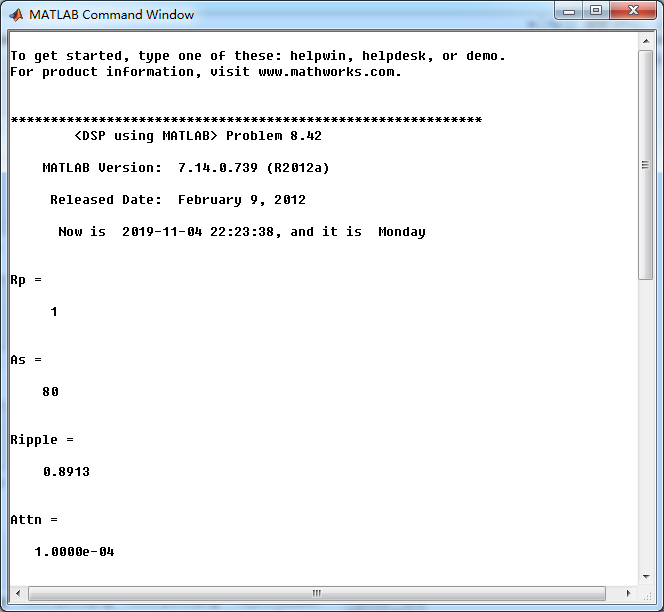
ellip函数(MATLAB工具箱函数)得到Elliptic带阻滤波器,阶数为10,系统函数串联形式系数如下图。
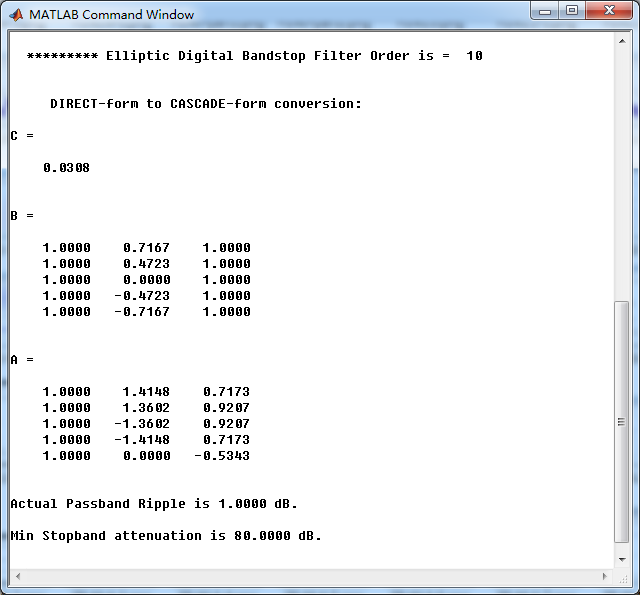
Elliptic带阻滤波器,幅度谱、相位谱和群延迟响应
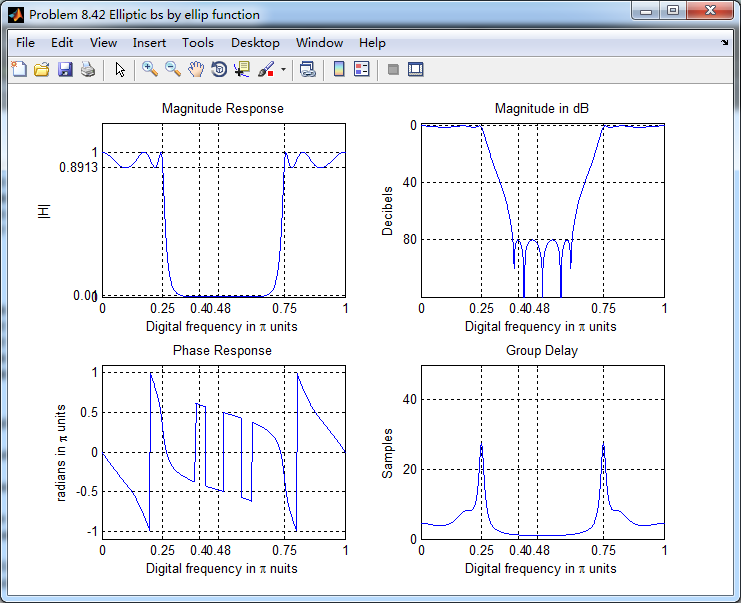
输入离散时间信号x(n)的谱如下,可看出,频率分量0.44π
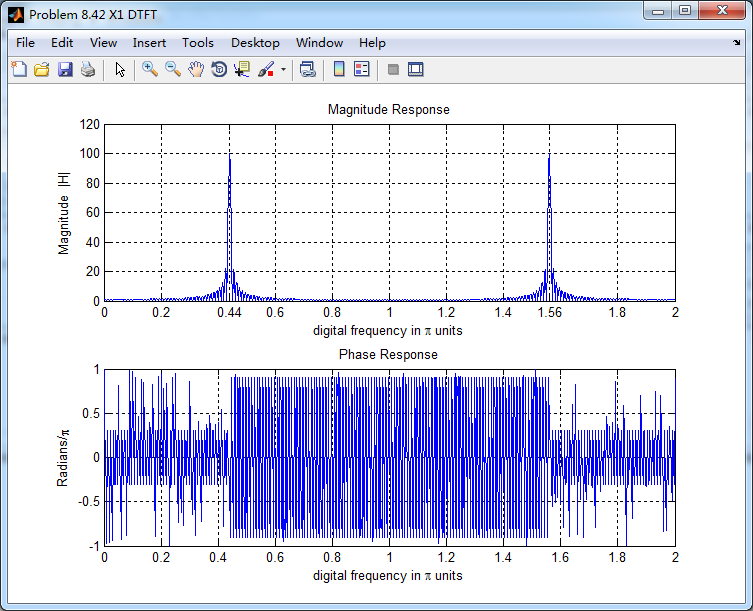
通过带阻滤波器后,得到的输出y(n)的谱,好像变乱了,o(╥﹏╥)o
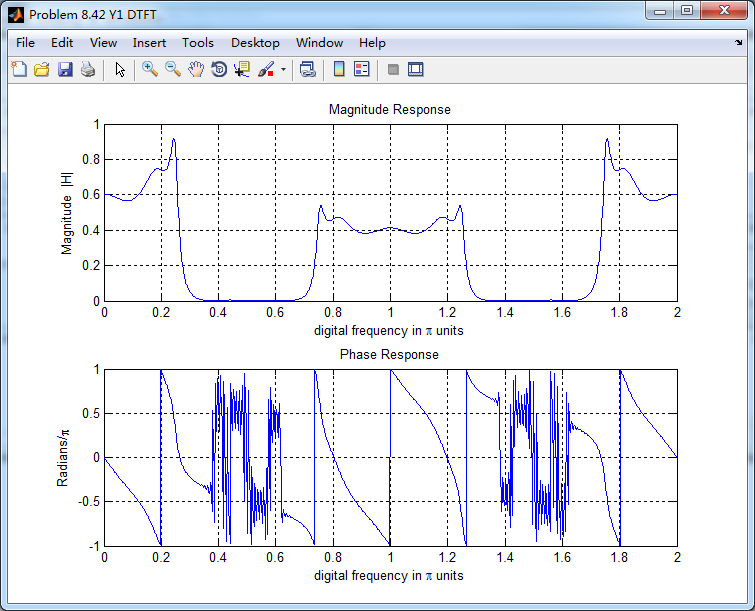
输入和输出的离散时间序列如下图
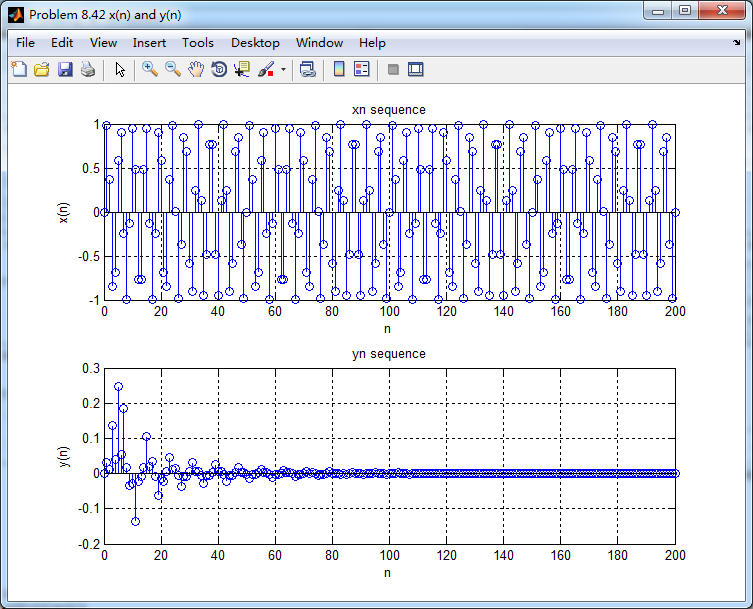
《DSP using MATLAB》Problem 8.42的更多相关文章
- 《DSP using MATLAB》Problem 7.14
代码: %% ++++++++++++++++++++++++++++++++++++++++++++++++++++++++++++++++++++++++++++++++ %% Output In ...
- 《DSP using MATLAB》Problem 7.27
代码: %% ++++++++++++++++++++++++++++++++++++++++++++++++++++++++++++++++++++++++++++++++ %% Output In ...
- 《DSP using MATLAB》Problem 7.26
注意:高通的线性相位FIR滤波器,不能是第2类,所以其长度必须为奇数.这里取M=31,过渡带里采样值抄书上的. 代码: %% +++++++++++++++++++++++++++++++++++++ ...
- 《DSP using MATLAB》Problem 7.25
代码: %% ++++++++++++++++++++++++++++++++++++++++++++++++++++++++++++++++++++++++++++++++ %% Output In ...
- 《DSP using MATLAB》Problem 7.24
又到清明时节,…… 注意:带阻滤波器不能用第2类线性相位滤波器实现,我们采用第1类,长度为基数,选M=61 代码: %% +++++++++++++++++++++++++++++++++++++++ ...
- 《DSP using MATLAB》Problem 7.23
%% ++++++++++++++++++++++++++++++++++++++++++++++++++++++++++++++++++++++++++++++++ %% Output Info a ...
- 《DSP using MATLAB》Problem 7.16
使用一种固定窗函数法设计带通滤波器. 代码: %% ++++++++++++++++++++++++++++++++++++++++++++++++++++++++++++++++++++++++++ ...
- 《DSP using MATLAB》Problem 7.15
用Kaiser窗方法设计一个台阶状滤波器. 代码: %% +++++++++++++++++++++++++++++++++++++++++++++++++++++++++++++++++++++++ ...
- 《DSP using MATLAB》Problem 7.13
代码: %% ++++++++++++++++++++++++++++++++++++++++++++++++++++++++++++++++++++++++++++++++ %% Output In ...
随机推荐
- mysql|tomcat|nginx|redis在docker中的部署
MySQL部署 拉取MySQL镜像 docker pull mysql 查看镜像 创建MySQL容器 docker run -di --name pinyougou_mysql -p 33306:33 ...
- Ext 消息框
<!DOCTYPE html> <html lang="en"> <head> <meta charset="UTF-8&quo ...
- Linux网卡驱动(4)—DM9000网卡驱动程序完全分析
1.硬件连接 mini2440开发板上DM9000的电气连接和mach-mini2440.c文件的关系 其中片选信号AEN使用了nGCS4,所以网卡的内存区域在BANK4,也就是从地址0x200000 ...
- XSS漏洞的渗透利用另类玩法
XSS漏洞的渗透利用另类玩法 2017-08-08 18:20程序设计/微软/手机 作者:色豹 i春秋社区 今天就来讲一下大家都熟悉的 xss漏洞的渗透利用.相信大家对xss已经很熟悉了,但是很多安全 ...
- Python 中练习题涉及到的无穷大和无穷小问题。
首先来看一下所见的python联系题. inf = infinite 无限制的 float("inf")-1执行后的结果是:() A 1 B inf C -inf D 0 该考点考 ...
- [转] Linux下编写脚本实现Daemon
在Linux(以Redhat Linux Enterprise Edition 5.3为例)下,有时需要编写Service.Service也是程序,一般随系统启动用户不干预就不退出的程序,可以称为Se ...
- CH1201 最大子序和 (单调队列)
题目链接: AcWing 牛客 题目描述 输入一个长度为n的整数序列,从中找出一段不超过m的连续子序列,使得整个序列的和最大. 例如 1,-3,5,1,-2,3 当m=4时,S=5+1-2+3=7 当 ...
- 自定义hive文件和记录格式及文本文件数据编码
(1)一段 建表语句: [ROW FORMAT row_format] [STORED AS file_format] | STORED BY 'storage.handler.class.name' ...
- hdu6395 /// 优先队列dijkstra
题目大意: 给定无向图的n m为点数和边数 接下来m行给定u v id表示点u到点v间有一条编号为id的边 当由一条边走到另一条边 而两条边的编号不同时 费用+1 优先队列跑dijkstra最短路 按 ...
- JavaScript中的面向对象编程,详解原型对象及prototype,constructor,proto,内含面向对象编程详细案例(烟花案例)
面向对象编程: 面向:以什么为主,基于什么模式 对象:由键值对组成,可以用来描述事物,存储数据的一种数据格式 编程:使用代码解决需求 面向过程编程: 按照我们分析好的步骤,按步 ...
